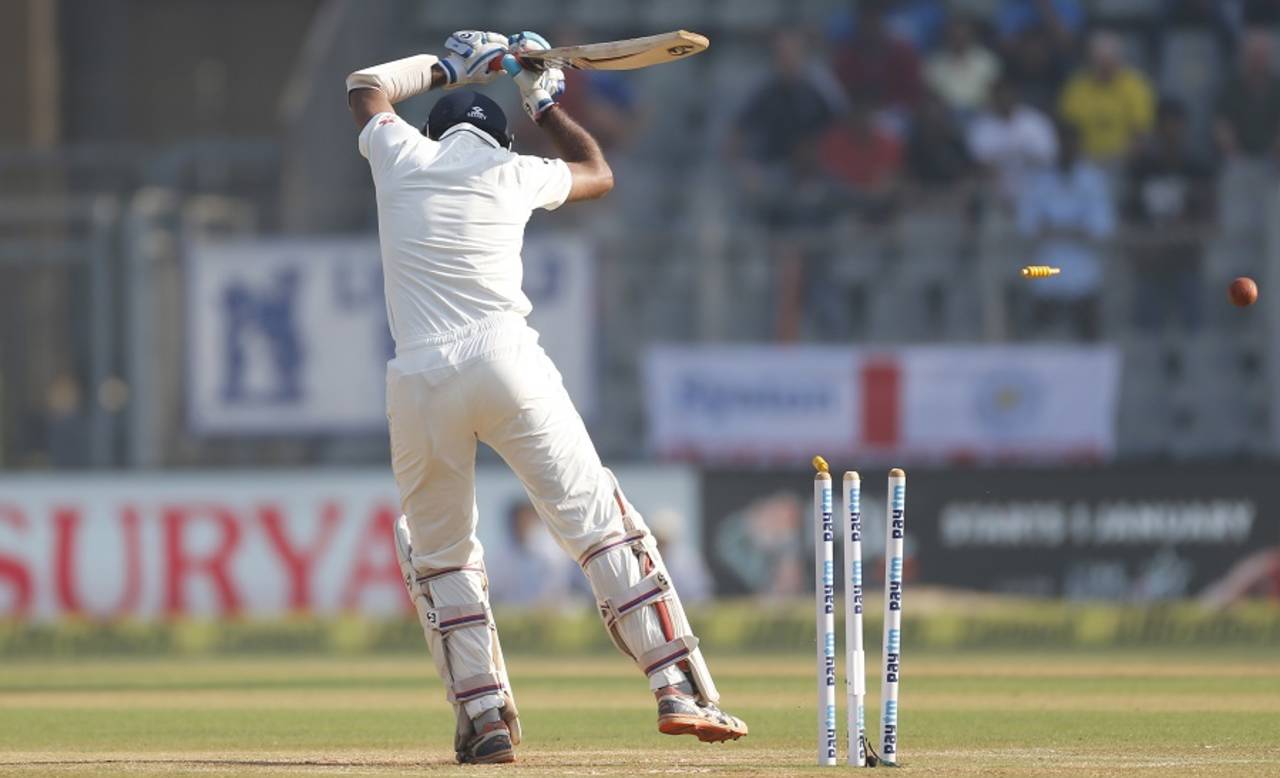England spinners' Jekyll-and-Hyde show
Jake Ball's tactful use of angles and Alastair Cook's problem of having too many bowling options feature in Aakash Chopra's technical breakdown of the third day's play in Mumbai

Cheteshwar Pujara was lured into shouldering arms to a ball he should have played • Associated Press
Jake Ball is playing only his second Test but has shown maturity in using the crease. He has gone to the corner of the box while bowling bouncers and has come closer to the stumps to bowl fuller. The first ball of the third day was bowled from the outside half of the box and Pujara left it comfortably. The second ball that dismissed Pujara was bowled from closer to the stumps and while the length remained almost identical, the closer release point ensured the ball pitched six inches closer. Pujara failed to read the subtle variation and let it go, instead of playing, and was bowled.
The fact that fast bowlers have taken only one wicket is this Test suggests that the pitch is spin-ready right from the outset. While the pitch has definitely assisted spinners, one must not start assuming that if you're a spinner, you will be among the wickets. Engand's spinners have realised the importance of peppering the same length and also that it is difficult to do consistently. The lack of bounce on most Indian pitches allow you to get away even when you miss the length by a foot on either side but the red-soil Wankhede pitch is severe if you err in length. The ball sits up to get hit. It's not often in Test cricket that you see so many full tosses and half-trackers.

Adil Rashid was held back until the 22nd over of the day. He might have been expensive on the second day, but it's unfair to ignore the fact he is England's most successful bowler in the series. Alastair Cook has an option too many at his disposal and one way or the other, one bowler gets under-bowled. Chris Woakes has bowled only eight overs so far and he did not bowl in the first 70 overs on third day. It won't be an exaggeration to say that England have played with ten players in most games in this series.
We, the players from north India, are given invaluable advice while traveling to the western part of the country. In Delhi and Mohali you can easily manage with low hands while defending but on pitches with extra bounce it's critical to keep the hands higher.

India waited for 121 overs to opt for the second new ball. England took it after 129. Mohammed Shami's absence and the presence of R Ashwin and Ravindra Jadeja could explain India's approach but England's choice was interesting. They have played as many as four fast bowlers, and both Rashid and Moeen Ali haven't bowled with the same penetration. Also, the absence of reverse-swing could have prompted such a different approach.
James Anderson found the outside edge of Jayant Yadav's bat in the first over with the second new ball. Because he had bowled only 12 overs till then, a long spell was expected from Anderson. But surprisingly he bowled only 2.4 overs with the new ball. It was equally baffling that even Woakes bowled only two overs from the other end. In addition, the lack of bouncers after the morning session showed poor planning.
Aakash Chopra is the author of three books, the latest of which is The Insider: Decoding the craft of cricket. @cricketaakash